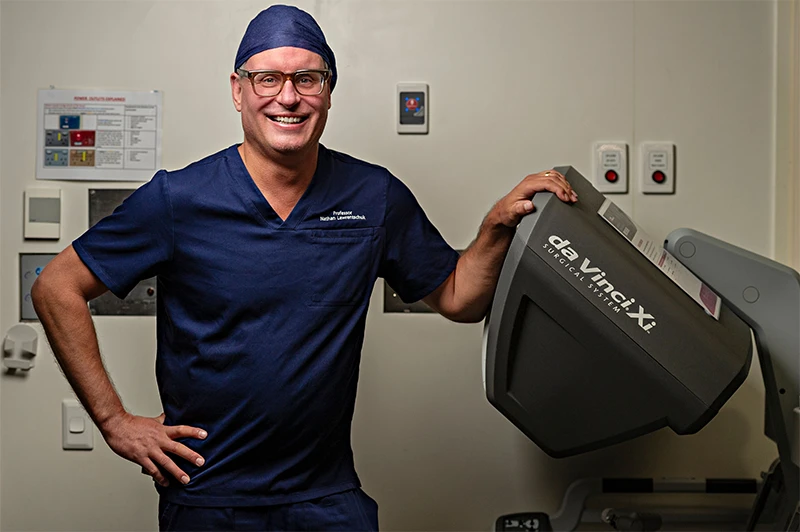A Robotic Assisted Radical Prostatectomy (RARP) is a surgical procedure to remove the prostate gland and, when appropriate, the seminal vesicles and surrounding lymph nodes. It is typically performed for men with localised prostate cancer. If successful, this procedure can offer a curative outcome.
What does ‘robotic’ mean?
Prof Lawrentschuk utilises the da Vinci robotic system, which enhances precision, vision, and control during surgery. Despite the name, the robot does not function independently. Every movement is fully controlled by Prof Lawrentschuk via a console.
The benefits of robotic surgery include:
- Smaller incisions
- Reduced bleeding and postoperative pain
- Shorter hospital stay
- Faster recovery time
- Lower risk of infection
Alternative treatment options
Your treatment pathway will be determined by several factors including cancer grade, stage, location, age, and overall health. Prof Lawrentschuk will guide you through available options, which may include:
Radiotherapy
- Uses high-energy beams to destroy cancer cells
- Often combined with hormone therapy to suppress testosterone
- Outpatient therapy typically administered over several weeks
Active Surveillance
- No immediate intervention
- Ongoing monitoring with PSA tests, MRIs, and biopsies
- Suitable for slow-growing prostate cancers
- May allow delay or avoidance of treatment
Other surgical options
- Focal Therapy
- Available for select patients - only targets focal cancers
- Please discuss with Prof Lawrentschuk if you are interested.
- Open or Laparoscopic Radical Prostatectomy
- Alternative approaches with similar goals but may have longer recovery times.
Read Prof Lawrentschuk's patient info page on Focal Therapy
Before surgery
You will be contacted 1–2 weeks prior to your scheduled procedure with specific fasting instructions and hospital admission details. You will also receive a link to complete your online admission forms.
It is important to advise the rooms if you are taking any blood thinners or any prescribed medications for diabetes or weight loss purposes. The rooms can be contacted on 03 9329 1197.
Following surgery
Hospital stay
You’ll be admitted on the day of surgery. The operation typically takes 2–3 hours, and you'll stay in hospital for 3–5 nights.
You’ll wake up with:
- A urinary catheter (to stay for 7–10 days)
- Small dressings over abdominal incisions
- Possibly a drain (removed before discharge)
Recovery at home
Catheter Care
You will be discharged with a urinary catheter connected to a leg bag. Nursing staff will show you how to:
- Empty and clean the bag
- Secure the catheter comfortably
- Watch for signs of infection
Catheter removal usually occurs 7–10 days later during a follow-up appointment scheduled with our Specialist Urology Nurse at Epworth Freemasons, Grace.
Activity
- Walking is encouraged as soon as possible
- Avoid heavy lifting or strenuous activity for 4–6 weeks
- You may return to work within 2–4 weeks, depending on how you feel
- Resume sexual activity when comfortable - please note that erectile function may take time to return
Diet & Bowels
- Eat a balanced diet and stay hydrated
- Please seek medical advice if constipation occurs and is not managed with a high-fibre diet
Common side effects
- Tiredness
- Mild pain or bruising
- Blood in urine
- Urinary leakage
- Erectile dysfunction - may improve over 12–24 months, especially if nerve-sparing surgery was possible
- Incontinence - most men improve with pelvic floor exercises, though some may need pads
- Infertility - you will no longer ejaculate semen (dry orgasm), and natural conception is not possible
- Positive surgical margins - if some cancer remains, further treatment may be needed
Less common side effects
Persistent urinary leakage
3–5%
Infection or wound issues
2–10%
Lymphocoele (fluid collection)
2–10%
Urine leak from bladder join
< 2%
Nerve injury symptoms (numbness, tingling)
< 2%
Significant bleeding
< 1%
Bowel injury or need for conversion to open surgery
rare
Follow-up and monitoring
You will have ongoing follow-up appointments to monitor recovery and PSA levels:
- First review after catheter removal - 8 weeks post-operative review
- Repeat PSA testing every 3–6 months in the first year
- Ongoing surveillance for 5 years or longer
If further treatment is required, options such as radiation therapy, hormone therapy, or clinical trials may be discussed.
When to seek help
If you have any of the following symptoms, please call Prof Lawrentschuk’s rooms on 03 9329 1197 or present to your local Emergency Department.
- Heavy bleeding or large clots in your urine
- If you cannot pass any urine at all
- Thick, cloudy or smelly urine
- High temperatures, shivers or shakes
- Painful or swollen testicles
The following symptoms are normal when healing, please monitor them and seek advice if they worsen or persist.
- Small clots or blood-tinged urine
- Leaking of urine around catheter
- Tiredness or fatigue
- Bruising or soreness around your wounds
If you have any queries, please use the contact details below:
MONDAY to FRDAY 8:30AM–4:00PM
Call the rooms at 9329 1197
AFTER HOURS
Contact Epworth Emergency on 03 9426 6666 or Royal Melbourne Emergency on 03 9342 7000.
You can also page Prof Lawrentschuk on 03 9387 1000.
For appointments and enquiries:
CONSULTING LOCATIONS


